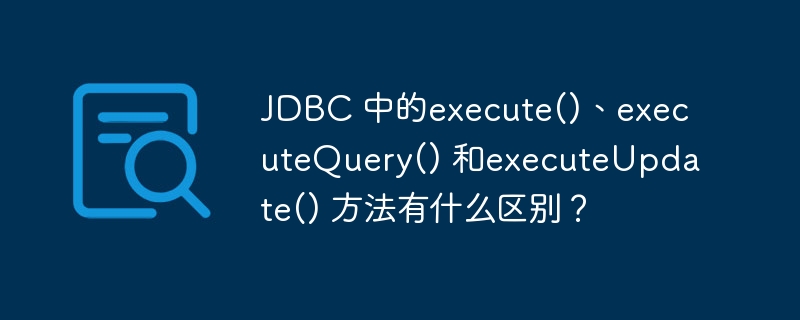집 >데이터 베이스 >MySQL 튜토리얼 >JDBC의 Execute(), ExecuteQuery() 및 ExecuteUpdate() 메소드의 차이점은 무엇입니까?
JDBC의 Execute(), ExecuteQuery() 및 ExecuteUpdate() 메소드의 차이점은 무엇입니까?
- WBOY앞으로
- 2023-09-17 14:33:121438검색

Statement 객체를 생성한 후에는 State 인터페이스의 Execution(), ExecuteUpdate() 및 ExecuteQuery() 메서드 중 하나를 사용하여 이를 실행할 수 있습니다.
execute() 메서드: 이 메서드는 SQL DDL 문을 실행하는 데 사용됩니다. ResultSet 개체를 검색할 수 있는지 여부를 지정하는 부울 값을 반환합니다.
Example
import java.sql.Connection;
import java.sql.DriverManager;
import java.sql.SQLException;
import java.sql.Statement;
public class Example {
public static void main(String args[]) throws SQLException {
//Registering the Driver
DriverManager.registerDriver(new com.mysql.jdbc.Driver());
//Getting the connection
String mysqlUrl = "jdbc:mysql://localhost/sampleDB";
Connection con = DriverManager.getConnection(mysqlUrl, "root", "password");
System.out.println("Connection established......");
//Creating the Statement
Statement stmt = con.createStatement();
//Executing the statement
String createTable = "CREATE TABLE Employee( "
+ "Name VARCHAR(255), "
+ "Salary INT NOT NULL, "
+ "Location VARCHAR(255))";
boolean bool = stmt.execute(createTable);
System.out.println(bool);
}
}Output
Connection established...... false
executeUpdate(): 이 메서드는 삽입, 업데이트, 삭제 및 기타 문을 실행하는 데 사용됩니다. 영향을 받은 행 수를 나타내는 정수 값을 반환합니다.
Example
import java.sql.Connection;
import java.sql.DriverManager;
import java.sql.SQLException;
import java.sql.Statement;
public class ExecuteUpdateExample {
public static void main(String args[]) throws SQLException {
//Registering the Driver
DriverManager.registerDriver(new com.mysql.jdbc.Driver());
//Getting the connection
String mysqlUrl = "jdbc:mysql://localhost/sampleDB";
Connection con = DriverManager.getConnection(mysqlUrl, "root", "password");
System.out.println("Connection established......");
//Creating the Statement
Statement stmt = con.createStatement();
String insertData = "INSERT INTO Employee("
+ "Name, Salary, Location) VALUES "
+ "('Amit', 30000, 'Hyderabad'), "
+ "('Kalyan', 40000, 'Vishakhapatnam'), "
+ "('Renuka', 50000, 'Delhi'), "
+ "('Archana', 15000, 'Mumbai')";
int i = stmt.executeUpdate(insertData);
System.out.println("Rows inserted: "+i);
}
}Output
Connection established...... Rows inserted: 4
executeQuery(): 이 메서드는 테이블 형식 데이터(예: select)를 반환하는 문을 실행하는 데 사용됩니다. ResultSet 클래스의 객체를 반환합니다.
예
import java.sql.Connection;
import java.sql.DriverManager;
import java.sql.ResultSet;
import java.sql.SQLException;
import java.sql.Statement;
public class ExecuteQueryExample {
public static void main(String args[]) throws SQLException {
//Registering the Driver
DriverManager.registerDriver(new com.mysql.jdbc.Driver());
//Getting the connection
String mysqlUrl = "jdbc:mysql://localhost/sampleDB";
Connection con = DriverManager.getConnection(mysqlUrl, "root", "password");
System.out.println("Connection established......");
//Creating the Statement
Statement stmt = con.createStatement();
//Retrieving data
ResultSet rs = stmt.executeQuery("Select *from Employee");
while(rs.next()) {
System.out.print("Name: "+rs.getString("Name")+", ");
System.out.print("Salary: "+rs.getInt("Salary")+", ");
System.out.print("City: "+rs.getString("Location"));
System.out.println();
}
}
}출력
Connection established...... Name: Amit, Salary: 30000, City: Hyderabad Name: Kalyan, Salary: 40000, City: Vishakhapatnam Name: Renuka, Salary: 50000, City: Delhi Name: Archana, Salary: 15000, City: Mumbai
위 내용은 JDBC의 Execute(), ExecuteQuery() 및 ExecuteUpdate() 메소드의 차이점은 무엇입니까?의 상세 내용입니다. 자세한 내용은 PHP 중국어 웹사이트의 기타 관련 기사를 참조하세요!
성명:
이 기사는 tutorialspoint.com에서 복제됩니다. 침해가 있는 경우 admin@php.cn으로 문의하시기 바랍니다. 삭제

